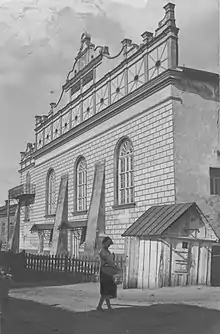| Great Maharsha Synagogue | |
|---|---|
 | |
| Religion | |
| Affiliation | Judaism |
| Rite | Ashkenazi |
| Location | |
| Location | Ostroh, Rivne Oblast, Ukraine |
| Geographic coordinates | 50°19′45″N 26°31′11″E / 50.32917°N 26.51972°E |
| Architecture | |
| Architect(s) | Giacomo Madlena[1] |
| Style | Baroque[1] |
| Date established | after 1627 |
The Great Maharsha Synagogue (Hebrew: בית הכנסת המהרש״א) was a synagogue in Ostroh, named after Rabbi Shmuel Eidels.
It was built after 1627 under a restriction "prohibiting the erection of synagogues taller than churches."[2] During the Russo-Polish War of 1792, the Russian army under General Kakhovsky (according to Alexander Suvorov, but this is not true) approached Ostroh. The frightened Jews locked themselves in the synagogue to save their lives. Meanwhile, the Polish army left the city, not ready to resist because of its small numbers. The Russians, believing that the synagogue was a castle, shelled the building with cannons for two days.
After explaining to them that the Poles had long since left the city, he showed the Russians the ford across the Vilia River (the bridge was burned by the Poles during their retreat). Later, as a sign of this miraculous rescue, the place on the south wall where the cannonball hit was not plastered, and the other cannonball was hung under the vault in the prayer hall.
In 1912, the church was overhauled. The western façade was decorated with rusticated wood. The attic of the northern extension was remodeled. The interior was painted. As a result of the fighting during World War II, the building was heavily damaged. In 1941, it was destroyed and looted by the Nazi occupiers. The loopholes on the main façade and the buttresses between the windows were completely destroyed.
In 1960, the building suffered significant losses and was turned into a warehouse. The eastern part was destroyed, as well as most of the northern part and the attic of the western façade. Only the prayer hall has survived, redesigned on three floors (the interfloor ceilings were removed in 2002).
The synagogue was damaged during the Khmelnytsky massacres and centuries later, once again, during the Holocaust. It was used as a warehouse during the Soviet era, and later abandoned. Reconstruction of the ruins began in 2016 under the leadership of Hryhoriy Arshynov.[3][4][5]
References
- 1 2 "Great Maharsha Synagogue in Ostroh". Historical Synagogues of Europe. The Center for Jewish Art. Retrieved April 6, 2022.
- ↑ Kravtsov, Sergey R. (December 17, 2015). "The Great Maharsha Synagogue in Ostroh: Memory and Oblivion. Have we reached the point of no return?". Jewish Heritage Europe. Retrieved April 6, 2022.
- ↑ "The Synagogue in Ostroh: Reconstruction of the ruins". Ukraïner. August 5, 2020. Retrieved April 6, 2022.
- ↑ "Ukraine: Great Maharsha Synagogue in Ostroh has a new roof". Jewish Heritage Europe. March 12, 2017. Retrieved April 6, 2022.
- ↑ "A great loss to Ukrainian-Jewish heritage". Ukrainian Jewish Encounter. November 3, 2020. Retrieved April 6, 2022.